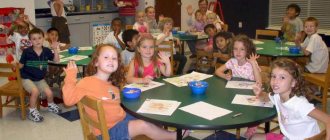Construct for learning a poem
Construct
organization of direct educational activities
according to PM.03 Organization of classes in basic general education programs of preschool education
Volchikhina Ekaterina Andreevna
(specialty 44.02.01 Preschool education, group 43 “A”)
DOO:
№5
Group:
senior group (5 - 6 years old)
GCD type:
speech development
Methodologist for practice:
Solomina Elena Vladimirovna
Subject:
poem by G. Vieru “Mother’s Day”
Educational area:
“Speech development”, “Socio-communicative development”
Form of conducting GCD:
frontal, individual
Kind of activity:
cognitive, motor
Target:
developing children’s skills to learn the poem “Mother’s Day” by heart.
Planned result:
Children are motivated to work together;
Children show curiosity and activity in the process of memorizing the poem “Mother's Day”;
Children improve their dialogical speech: the ability to answer adult questions;
Children are familiar with G. Vieru’s poem “Mother’s Day”
Children show interest in fiction and a desire to listen to literary works;
Children show an emotional response to the content of a literary work;
Children answer questions during communication;
In children, muscle tension is relieved;
Children memorize the poem;
Children develop auditory and visual memory, voluntary attention;
Children can read expressively by heart using mnemonics;
Children are able to reproduce the rhythm of a poem and use speech breathing correctly;
Children show a friendly attitude towards peers in the process of joint activities, the ability to listen to each other, and not interrupt;
Children are able to analyze the process and result of their activities;
Children know how to communicate their impressions and desires;
Children improve their dialogical speech;
Children are motivated to engage in independent activities in routine moments.
| Tasks | Tasks taking into account the characteristics of the group’s students |
| Educational: cultivate an interest in fiction, a desire to listen to a literary work; cultivate an emotional response to the content of a literary work; cultivate a friendly attitude towards peers in the process of joint activities, the ability to listen to each other, not interrupt Educational: develop curiosity and activity in the process of memorizing a poem; develop the ability to answer adult questions; develop auditory and visual memory, voluntary attention mnemonics; develop the ability to reproduce the rhythm of a poem and correctly use speech breathing. Educational: introduce children to G. Vieru’s poem “Mother’s Day”; encourage children to memorize the poem; teach children to read expressively by heart using mnemonics; to develop in children the ability to analyze the process and result of their activities” to develop in children the ability to report their impressions and desires. |
LEARNING POEMS WITH CHILDREN IN THE SECOND YOUNGER GROUP OF KINDERGARTEN
By the end of their stay in the second junior group, preschoolers should know at least 12 poems. Program poems are small in volume and are easily remembered by children. The only exception is the nursery rhyme “Bucket Sun”, which children are introduced to at the beginning of the year. It is not immediately memorable like other poems. Therefore, it is advisable that the teacher tell it to the children more than once: while getting dressed for a walk, in the area (especially on cloudy days), etc. Having memorized the nursery rhyme, the children read it on their own.
When memorizing poems, children should be shown the objects and toys they talk about (a horse, a bear cub with a bandaged paw, a flag, etc.). In some cases, a toy can be used as an object for staging. So, the teacher reads the poem “Horse” by A. Barto and
This “combs the horse’s fur smoothly”, “smoothes the tail with a comb.” Then he repeats the text 2-3 times with the participation of the children. In other cases, the demonstrated toy (picture) encourages children to make statements, which the teacher summarizes with lines of a poem, and the kids, having repeated them, easily remember them. For example, in front of the children there is a bear cub with a bandaged paw. “Are you sick? Why is the paw tied?” - they are worried. “They dropped the bear on the floor...” the teacher quotes. And asks: “Do you understand what happened?” Three or four children talk about what happened (repeat the phrase “They dropped the bear...”).
In order for a child to remember a poem (part of it), repeated repetition is necessary. Children quickly get bored with it, so you need to find motivations that are meaningful for kids. For example, the teacher reads: “The wind walks across the sea and pushes the boat…” At this time, one of the children depicts a boat sailing (a bright, plain headscarf is used). The teacher finishes reading the poem, and the child “swims” to one of the children and “lowers the sail” (gives a handkerchief to his peer), inviting him to pretend to be a boat. The teacher repeats the poem or instructs the child to do it.
As a rule, children prefer to watch and listen. Therefore, in order to encourage a child to read independently, it is advisable to also provide play motivation. So, after repeating the poem “The Horse” by A. Barto 2-3 times with the children, the teacher calls on a child who is brave and remembers the poems well. He offers to read a poem, and then allows you to sit on a horse (rocking toy) and ride it. At this time, the rest of the children can clatter “like horses.” Having independently read the poem “Flag” by O. Vysotskaya, the baby receives a flag and marches with it, and the children, imitating the drum roll, recite: tram-pum-pam, tram-pum-pam.
At the end of the lesson, many children should not be called upon to recite by heart. If the poem is short, easy to read and accompanied by playful actions, you can ask four people. In other cases, it is enough for 1-2 children to read the poem.
Outside of class, you need to remind children of the poems they have learned more often, and encourage their attempts to read the poem to the teacher and peers. At a matinee, 2-3 children can read the same program poem. This does not bother listeners and performers; the main thing for them is participation in the holiday.
Final classes to familiarize children with works of fiction are conducted in the form of literary quizzes. Using a wide variety of techniques used in a wide variety of combinations (recognize a book by its cover, picture, staged passage, etc.), the teacher repeats the material covered with the children and checks how well they have mastered it. Final classes are held once a quarter.
content .. 11 12 13 ..
Familiarization of preschool children with fiction
Such a conversation may include: a short story about the writer, a reminder of his other books that are already familiar to children. If children have been prepared by previous work to perceive a book, you can arouse their interest with the help of a riddle, a poem, or a picture. Next, you need to name the work, its genre (story, fairy tale, poem), and the name of the author.
Explanation of unfamiliar words is a mandatory technique that ensures a full perception of the work. It is necessary to explain the meanings of those words, without understanding which the main meaning of the text, the nature of the images, and the actions of the characters become unclear. The explanation options are different: substituting another word while reading prose, selecting synonyms (bast hut - wooden, upper room - room); the use of words or phrases by the teacher before reading, while introducing the children to the picture (“milk flows down the mark, and from the mark down the hoof” - when looking at the goat in the picture); asking children about the meaning of a word, etc.
Expressive reading, the interest of the teacher himself, his emotional contact with children increase the degree of impact of the literary word. While reading, children should not be distracted from perceiving the text with questions or disciplinary remarks; raising or lowering the voice or pausing is enough.
At the end of reading, while the children are impressed by what they heard, a short pause is necessary. Should we immediately move on to an analytical conversation? E. A. Flerina believed that it is most appropriate to support childhood experiences and strengthen the elements of analysis during repeated reading. A conversation started on the initiative of the teacher will be inappropriate, as it will destroy the impression of what was read. You can ask whether you liked the fairy tale and emphasize: “A good goldfish, how it helped the old man!”, or: “What a Zhikharka! Small and remote!”
At the end of the lesson, you can re-read the work (if it is short) and look at the illustrations, which deepen your understanding of the text, clarify it, and more fully reveal artistic images.
The method of using illustrations depends on the content and form of the book, and on the age of the children. The basic principle is that showing illustrations should not violate the holistic perception of the text. The main task of reading for a preschooler is to teach him to listen and hear (correctly perceive speech). A picture—an illustration placed in a children's book—helps the teacher present the child with a readable text, but it can also interfere with comprehension if shown at the wrong time.
When introducing a new book, it is advisable to first read the text to the children, and then look at the illustrations with them. It is necessary that the picture follows the word, and not vice versa - otherwise a bright picture can captivate children so much that they will only imagine it in their minds; the visual image will not merge with the word, because children will not “hear” the word, its sound shell they won't be interested. The exception is the colorful cover of the book, which arouses the natural interest and curiosity of children in this book.


